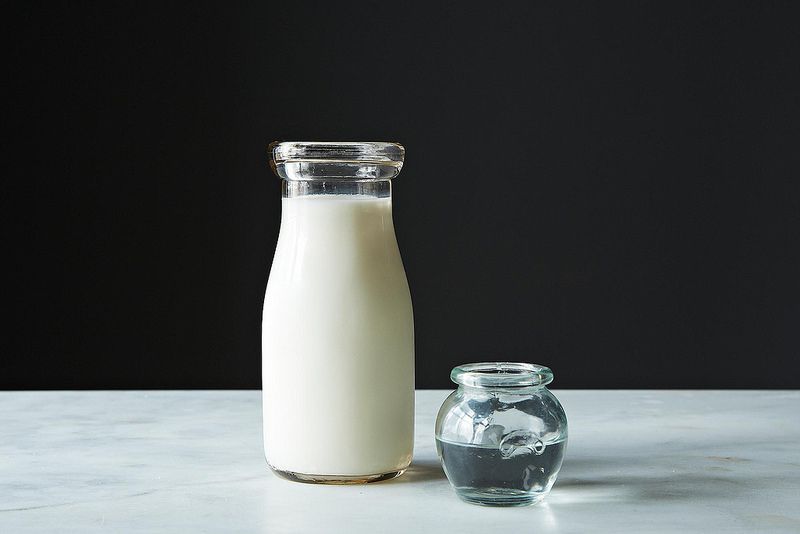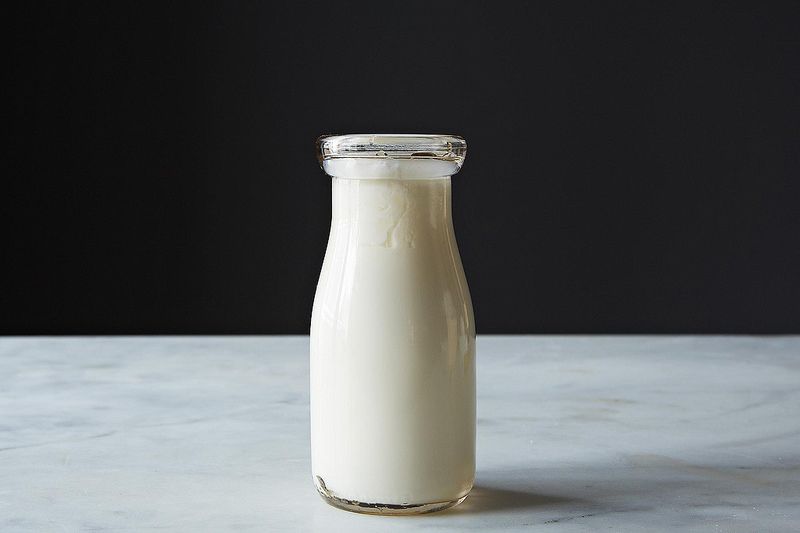Popular on Food52
30 Comments
jpriddy
September 11, 2016
I have used lemon juice, vinegar, and the whey that seeps out of yogurt into the hole I made by scooping. All will sour milk. The goal is to add flavor—the flavor of something sour. If the original recipe calls for buttermilk, it probably also includes baking soda, a leavening that requires acid. An alternative sour liquid is plain orange juice for those who arelactose-intolerant and another wonderful and fragrant flavor for the rest of us.
Kathy S.
January 20, 2015
There's also a dried product (similar to dried milk) that works perfectly fine once rehydrated. I keep a can of it in my cupboard for use in all recipes that require buttermilk.
Rosalind R.
February 3, 2014
That's not buttermilk. That's just sour milk. Real buttermilk is the liquid left after churning cream into butter. It should be fat free because all of the fat is in the butter. When I was growing up in the 1950s, farmers would sell a dipper of buttermilk at their vegetable stands. It's easy to make real buttermilk. Just buy a pint of heavy cream, put it in the blender, and churn it until it forms into butter and whey. The whey is the buttermilk.
Robin
February 3, 2014
If you read the information given above you can see the point of the article was not to reproduce real buttermilk, but rather to approximate a taste similar to it. Lebanese and Syrian markets often have yogurt drinks that do just that, which is why I wondered if they or diluted yogurt could work in a recipe. But thank you for reminding me of my former career teaching at a culinary college where the tone in the faculty lounge was (very) occasionally didactic. Whenever I hear that brand of pontification it takes me down memory lane.
Rosalind R.
February 4, 2014
Robin,
Thank you for putting me in my place. I shall take it as a compliment. If the only purpose of the artificial "buttermilk" is to reproduce its effect in cooking, than the only difference in the ingredients is the vinegar or lemon juice. Instead of making a bottle of ersatz buttermilk, simply add a small amount of lemon juice to the batter. That will give the pancakes or muffins the tangy taste of "buttermilk" and the acidity to increase the fluffiness. Why waste good milk when it isn't necessary?
Thank you for putting me in my place. I shall take it as a compliment. If the only purpose of the artificial "buttermilk" is to reproduce its effect in cooking, than the only difference in the ingredients is the vinegar or lemon juice. Instead of making a bottle of ersatz buttermilk, simply add a small amount of lemon juice to the batter. That will give the pancakes or muffins the tangy taste of "buttermilk" and the acidity to increase the fluffiness. Why waste good milk when it isn't necessary?
Robin
February 4, 2014
If a recipe calls for a cup of buttermilk then the ingredient is providing a cup of liquid as well as a sour taste. Any batter requires a certain amount of liquid. If you replace all the liquid in a recipe for biscuits or pancake batter with vinegar or lemon juice then you are making something quite different from the author's original intention.
Rosalind R.
February 4, 2014
I wasn't suggesting using lemon juice instead of milk but in addition to the milk or water already required for the recipe. So if the recipe calls for 1 cup of milk or water, toss an additional teaspoon of lemon juice or vinegar into the dry ingredients with the required liquid. Your idea of using thinned liquid yogurt would probably work too.
Rosalind R.
February 4, 2014
Correction, the instructions above say 1 tablespoon of acid per cup of milk; so add one tablespoon of vinegar or lemon juice directly to the dry mix per cup of liquid used.
Michael M.
February 2, 2015
So true,that's just sour milk ,English language so funny--eggplant, where is eggs ???
Robin
February 2, 2014
Has anyone ever sued yogurt thinned down with milk to replace buttermilk? I've toyed with the idea, but the store is so close I never had to.
Douglas
February 2, 2014
Have used 'dried buttermilk' with success ... and buttermilk keeps almost forever (ignore the BBD) as long as the carton is sealed.
AntoniaJames
January 28, 2014
Citric acid, which many cooks keep on hand for cheese making, works well, too. Use 1/4 teaspoon per cup of milk. I've used cider vinegar, too. My white vinegar remains banished in the garage with the cleaning products, where it belongs. It's too harsh for use in any cooking, including pickles. Trust me. (My kosher dills improved immeasurably when I started using white wine vinegar + cider vinegar instead of distilled white.) ;o)
Sarah J.
January 28, 2014
Thanks for the tip, AntoniaJames! I've never had a problem using white vinegar but I'm going to try making my buttermilk with cider vinegar and see if I get more palatable results.
Karen T.
January 28, 2014
SO, if I use buttermilk added to whole milk to make ricotta, would this work?
AntoniaJames
January 28, 2014
Do you use a recipe for the ricotta? I'd be concerned about doing a conversion here, given that you're asking the buttermilk in turn to curdle the other milk and cream. I'd look for a recipe that does not use buttermilk as the acid, but uses lemon or lime juice instead, in the first instance. ;o)
Douglas
February 2, 2014
A ricotta recipe that I use which works wonderfully - 1 ga whole milk, 1 pt heavy cream, 1 pt natural yogurt, 1 TBL salt and fresh ground nutmeg ... simmer/stir until raft of ricotta gets a hole in the middle.
Catherine L.
January 28, 2014
This is perfect! I always crave pancakes but never have buttermilk. Problem solved!
jpriddy
September 11, 2016
Have you tried making pancakes with orange juice? Add a 1/2 teaspoon of baking soda. I have a friend who is lactose intolerant, and this works well enough that I do it often.
Sarah S.
January 28, 2014
I've been using this method for years. I hate buying a whole thing of buttermilk when I usually only need less than a cup.
Marlene H.
February 2, 2014
I don't worry about buying a pint of buttermilk! it lasts for weeks??even opened
Josh P.
January 28, 2014
Cooks Illustrated had a short piece about this in last month's issue. They said that, while lemon juice or vinegar works, it often adds a taste that can't be avoided. They suggested using cream of tartar - an acid that will perform the same task as lemon or vinegar without any noticeable flavor change.
Sarah J.
January 28, 2014
That's a great tip. Thank you for sharing, Josh! Perhaps it's best to steer clear of lemon juice and vinegar and just go with cream of tartar when making dressings or other such recipes where the buttermilk flavor is highly noticeable.
Marian B.
January 28, 2014
I have also used apple cider vinegar, and it works quite nicely. Buttermilk for everyone!




See what other Food52 readers are saying.